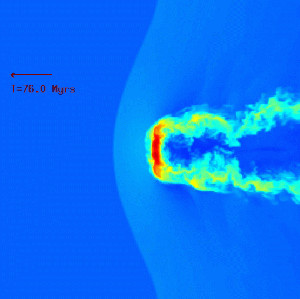 |
|
Fig. 1:
A schematic representation of an ALFALFA 3-dimensional data-cube.
Each pixel represents a position on the sky (defined by RA and Dec)
and a velocity, where each data cube is 2.4 by 2.4 degrees in size and
about 5500 km/s in velocity range (25 MHz in frequency). For each
pixel a value of the flux density is recorded. For each target, we
extract a spectrum over the velocity range from the data-cube at a
given position of the sky. Two examples of extracted spectra are
shown on the right, illustrating an HI detection (bottom) and
an HI non-detection (top).
Image credit: Fabello, S. et al, 2011, MNRAS, 411, 993
|
 |
 |
|
Fig. 2:
Example of stacked spectrum. Dotted lines show the
boundaries of the signal, inside which we integrate the flux to
compute the mass in atomic gas.
Image credit: Fabello, S. et al, 2011, MNRAS, 411, 993
|
 |
 |
|
Fig. 3:
Examples of nearby elliptical galaxies that have been found to possess
outer rings that are actively forming stars. In these images taken
with the Hubble space telescope, ultraviolet light from young hot
stars has been rendered in blue, while green and red light from the
galaxies is shown in their natural colours.
Image credit: NASA/ESA /JPL-Caltech/STScI /UCLA
|
 |
 |
|
Fig. 4:
A close-up of a simulation of a galaxy that is losing its gas through
the process of ram-pressure stripping. In physics, ram pressure is
the pressure exerted on a body which is moving through a fluid
medium. It causes a strong drag force to be exerted on that body. In
the case of a galaxy moving through the intergalactic gas, the ram
pressure may be capable of stripping the galaxy of much of its
interstellar gas. This will depend on the density of the ambient gas
and the velocity of the body.
Image credit: University of Zurich
|
|  |
For technological reasons, studies of the cold neutral gas in galaxies
have lagged far behind studies of the stars in galaxies. Stars emit
radiation at optical wavelengths, but cold hydrogen gas in atomic form
(HI) emits radiation at a wavelength of 21 cm and is only detectable
at radio wavelengths.
The last decade has seen renewed efforts to carry out HI surveys over
large areas of the sky using existing radio telescopes. The Arecibo
Legacy Fast ALFA (ALFALFA) survey is the most advanced of these. When
complete, ALFALFA will have detected more than 30,000 extragalactic HI
line sources. However, ALFALFA is still shallow compared to
state-of-the-art optical galaxy surveys, such as the Sloan Digital Sky
Survey. As a result, most of the galaxies detected in such surveys are
late-type spiral and irregular galaxies. Rather little is known about
cold gas in early-type elliptical and lenticular galaxies.
In collaboration with researchers at Cornell University, MPA
scientists developed a stacking tool that enabled them to measure the
average atomic gas content of early-type galaxies. Spectra were
extracted from the ALFALFA data "cubes" (see Figure 1) at the
positions of elliptical galaxies identified in the Sloan Digital Sky
Survey. Although the HI line was usually not detected in individual
spectra, it did appear when the spectra were carefully superposed (see
Figure 2). This allowed the MPA scientists to extract a measurement of
the mean HI gas mass for the combined sample of galaxies.
Interestingly, the mean HI mass fraction does not drop below two per
cent, even in the most massive and red elliptical galaxies. One
question is whether this gas is associated with the central spheroidal
component of the galaxy, or is spread over large radii in a disk or a
ring. The 4 arc minute Arecibo beam means that the location of the
gas is not known, but the MPA scientists used statistical techniques
to argue that the gas is not associated with the central spheroid, but
must be located in a disk. Interestingly, a population of elliptical
galaxies with outer rings of star formation has now been identified by
the Hubble Space Telescope (see Figure 3). Taken together, these
observations suggest that elliptical galaxies do occasionally accrete
gas from the external environment and form new stars.
MPA scientists also used their stacking tool to investigate atomic gas
in galaxies residing in galaxy groups. It has long been known that
galaxies residing in dense environments, such as groups and clusters,
form stars less actively than isolated galaxies. There has been
on-going debate about why this is so. One popular theory is that in
dense environments, galaxies can no longer accrete gas (the fuel for
star formation) from the external environment, and they simply starve
to death over a timescale of a few billion years. New results from
MPA scientists indicate that groups may be even more deadly to some
galaxies than previously believed. Low mass galaxies appear to
actually lose their cold atomic gas if they are in groups. This
process is termed "ram-pressure stripping" (see Figure 4) and was
previously believed to be effective only in very big clusters. If the
MPA results are to be believed, small galaxies are advised to live in
the countryside if they want to hang on to their food!
Future radio surveys will be hundreds of times more sensitive than
ALFALFA and will map the gas in hundreds of thousands of galaxies over
much of the sky. The scientists will thus obtain much more complete
information about how galaxies acquire and lose their gas.
Silvia Fabello, Barbara Catinella, Guinevere Kauffmann
Relevant science papers:
Fabello, Silvia; Catinella, Barbara; Giovanelli, Riccardo; Kauffmann,
Guinevere; Haynes, Martha P.; Heckman, Timothy M.; Schiminovich,
David;
"ALFALFA H I data stacking - I. Does the bulge quench ongoing star formation in early-type galaxies?",
MNRAS, 411, Issue 2, pp. 993-1012
 http://adsabs.harvard.edu/abs/2011MNRAS.411..993F http://adsabs.harvard.edu/abs/2011MNRAS.411..993F
Related links:
 The ALFALFA survey The ALFALFA survey
 The Sloan Digital Sky Survey The Sloan Digital Sky Survey
|





